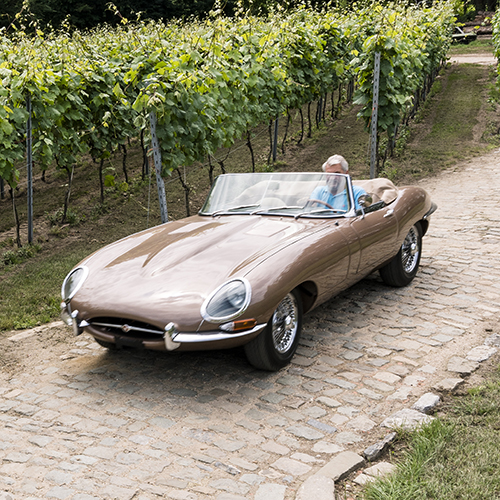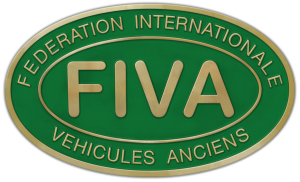60 Years of Jaguar E-Type

“The most beautiful car ever made” said Enzo Ferrari when Jaguar unveiled the Jaguar E-Type on 15 March 1961 at the Geneva Motor Show.
Apart from the noted presentation since then, the combination of top performance, beauty and competitive pricing made the Jaguar E-Type an icon in the automotive world.
This icon remained in production for 14 years.
The story of the Jaguar E-Type begins before 1961, however: after all, the design was based on the legendary Jaguar D-Type. This thoroughbred racing car astonished everyone by winning the 24 Hours of Le Mans in 1955, 1956 and 1957.
The E-Type for that matter received the innovative chassis of the D-Type for that time, with a subframe at the front containing the engine, with the front suspension and the hood, whereby Jaguar deviated from the traditional ladder chassis. This modified chassis construction made it possible to reduce the weight of the car to just 1315 kg for the coupe and even to 1256 kg for the convertible.
Jaguar introduced the E-Type as a 2-seater coupe (Fixed Head Coupe or FHC) and as an open two-seater (OTS) convertible. In 1966, a 2+2 coupe (with 4 seats and an extended wheelbase) was added to the range.
The first E-Types received the traditional XK6 3.8 litre 6-cylinder in-line engine that had proven its qualities in the Jaguar XK150S in particular. This engine had an output of 265 hp, which gave the E-Type a top speed of 241 km/h and enabled it to accelerate from 0 to 60 mph (97 km/h) in less than 7 seconds. In 1964, the E-Type was given a 4.2 litre 6-cylinder engine with the same amount of horsepower and performance but higher torque.
A total of 38,419 E-Type Series 1 cars were built, including 15,442 coupes, 17,378 roadsters and 5,599 2+2 coupes.
A “Lightweight” version was also developed (based on the Jaguar E-Type Series 1) intended as a follow-up to the glorious D-Type. Only about 12 of the 18 cars initially planned were built – on the basis of the roadster – and only a few remain today. Despite their 300 hp 3.8 litre engine with aluminium block, they were not a great success in sporting terms: in contrast to their C-Type and D-Type predecessors, their results in endurance races such as Le Mans and Sebring were poor. Only in smaller races – with the car mostly in the hands of private teams – were they reasonably successful.
The 1962 Low Drag Coupe by Lindner/Nöcker may be even more exclusive. An even more improved version of 1 of the 12 Lightweights, this was the only test car completed in 1962 and now resides in a private collection.
In 2014 Jaguar Heritage planned to build the 6 remaining “Light weights”, to the same specifications as the original 12 from 1963 and with the 6 unused chassis numbers.
Series 2 (1968-1971)
The Series 2 of the Jaguar E-Type underwent few changes compared to the Series 1. Externally, it is recognizable primarily by the absence of the glass headlight covers, the larger front turn signals, and the rear lights placed under the redesigned rear bumper. The front grille was enlarged – in combination with 2 electric fans – to increase the cooling capacity of the engine.
There were hardly any changes on the engine front either. For the American market the traditional SU carburettors were replaced by two Strombergs which reduced power and torque slightly.
18,809 cars of the Series 2 were built.
Series 3 (1971-1974)
The Jaguar E-Type underwent its most drastic change with the launch of the Series 3 in 1971. The typical 6-cylinder inline engine was replaced by an imposing 5.3 litre V12 engine. It boasted 272 hp thanks to 4 Zenith carburettors. The Jaguar E-Type was now also available with automatic transmission. Power steering was now also standard.
In terms of bodywork, only the FHC Coupé 2+2 and the OTS Roadster were produced.
Typical features for the Series 3 include: the large grille with crossed slats, the flared wheel arches, wider tires, 4 exhaust pipes and of course the V12 badge on the rear. The large, high windshield of the Jaguar E-Type Series 3 in the Coupe version was not to everyone’s liking. Also, the bumper modifications made for the US market and the extra blinkers on the flanks did not give the car a nicer look from the word go.
15,287 cars of the Jaguar E-Type series were built. In June 1974, the last Jaguar E-Type – an OTS Roadster – rolled off the production line.
General information
The Antwerp Classic Salon is an organisation of S.I.H.A. Salons Automobiles BVBA
![]()
Jozef Nuytsstraat 1
2140 Antwerpen, Belgium
Click here for our privacy statement
CONTACT US
You still have questions about the Antwerp Classic Salon?
Please send us your message or enquiry via the contact form.


